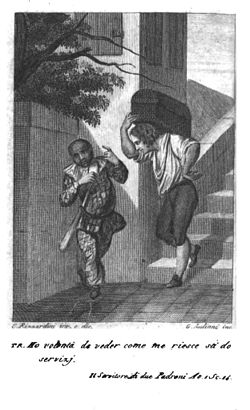Plot
Act 1
The play opens with the engagement party between Clarice and Silvio, the daughter and son of Pantaloon (also spelled Pantalone) and Doctor Lombardi respectively. However, their celebration is cut short by the arrival of the exceptionally quirky and comical Harlequin (known in English also as Truffaldino, which can be translated into English as Fraudolent), the servant of Clarice's supposedly deceased former fiancé, Federigo Rasponi. He reveals that Federigo is alive and wishes to renew his engagement, something Pantalone agrees to due to his money. Upon Federigo's entrance, it soon becomes apparent that 'Federigo' is actually his sister, Beatrice, disguised as her dead brother in search of the man who killed him, Florindo, who is also her lover. Her brother forbade her to marry Florindo, and died defending his sister's honor. She intends to go through with the engagement to Clarice, take the dowry money, locate Florindo, and flee. Brighella, a former acquaintance of the Rasponi's, is the only one to realize the deception, but keeps Beatrice's secret.
Harlequin soon meets Florindo, who has escaped to Venice, and talks his way in to also being a servant for him, with the intention of getting an extra dinner. Unaware they are searching for one another, Harlequin attempts to hide his involvement, despite the difficulty arising from them both staying at Brighella's inn. Silvio, determined to defeat "Federigo" and marry Clarice, asks Harlequin for his master, only for confusion to arise when he fetches Florindo instead. Harlequin invents a fake friend of his - "Pasqual" - as a reason for multiple confusions involving letters, resulting in him reading out a letter intended for Beatrice to Florindo and giving him Clarice's dowry money also intended for Beatrice. This leads Beatrice to believe something has happened to her money despite Pantalone's insistence it was all sent correctly.
Meanwhile, Clarice is distraught over Pantalone's decision to marry her to "Federigo" and refuses to speak to Beatrice, causing her to reveal her true identity. Clarice immediately changes her mind about Beatrice and agrees to help her, only for their new friendship to be mistaken as a willingness to marry.
Act 2
The situation also causes Doctor Lombardi to fall out with his friend, Pantalone. Silvio challenges Beatrice to a duel, only for him to easily defeat him. Clarice refuses to reveal Beatrice's secret causing Silvio to become angry and her to turn his sword on herself, but they are interrupted by Smeraldina (Pantalone's feisty servant, who is smitten with Truffaldino), who defends Clarice's honor causing her to change her mind and leave.
The most famous set-piece of the play occurs when the starving Harlequin tries to serve a banquet to the entourages of both his masters without either group becoming aware of the other, while desperately trying to satisfy his own hunger at the same time.
Smeraldina and Harlequin flirt, and he awkwardly attempts to admit his attraction to her. They decide to open and read a letter Smeraldina has been tasks with delivering to "Federigo" only to be halted as neither of them can read, or know Italian. They are caught by Beatrice and Pantalone, and when Harlequin is forced to make another cover story for Florindo, he accidentally gets himself in trouble again. Frustrated, he calls for an interval.
Act 3
Harlequin rejoices in finally having a full meal. He is then tasked with airing out the clothes for both of his masters, only to become confused and put the wrong clothes in the each trunk. When Florindo finds an item of Beatrice's, Harlequin lies that he inherited the trunk from a previous, now deceased master, convincing Florindo that Beatrice has died. He uses the same tactic on Beatrice, convincing her that Florindo is dead. Her impassioned plea after this revelation inadvertently reveals her true identity to him and the entering Pantalone who immediately heads to Doctor Lombardi to have Silvio engaged to Clarice again. However, he insults Pantalone and refuses, although Silvio is delighted.
Florindo and Beatrice both attempt to hang themselves at the same time, unaware they are directly next to each other. After realizing, they both are cut down and reunite happily. In an attempt to further hide his deception, Harlequin lies separately to Florindo and Beatrice by stating that his friend Pasqual was the others servant and the actual one that caused the confusion, before then continuing in his charade of secretly working for the both of them.
Clarice and Silvio are happily engaged again, and Clarice's aid of Beatrice is revealed. Florindo and Beatrice arrive, finally clearing up the confusion over who Beatrice was. The last matter up for discussion is whether Harlequin and Smeraldina can get married, which at last exposes Harlequin's having played both sides all along. However, as everyone has just decided to get married, Harlequin is forgiven. Harlequin asks Smeraldina to marry him.
This page is based on this
Wikipedia article Text is available under the
CC BY-SA 4.0 license; additional terms may apply.
Images, videos and audio are available under their respective licenses.
